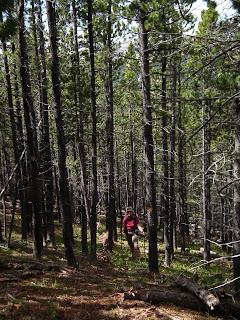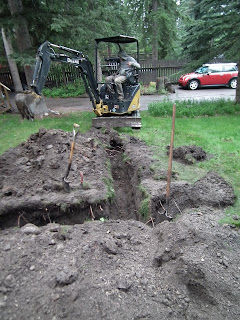I'm also a member of the Bow Valley Stewards, who's prime mandate is trail maintenance in Kananaskis Country.
Huh?
The Stewards work for Parks under the direction of a Conservation Officer. We do all sorts of jobs, including pull plants that bears use for food that grow in campgrounds, close trails that are in places they shouldn't be, track collared bears, ask fishermen about their catch, and the like.
The Friends are a non-profit organization with reps from Parks on the board including a Conservation Officer. After a few years without much focus (including doing such tasks as manning the retail outlets in the Kananaskis Visitors Centers and managing the Memorial Bench program), now the Friends mostly build new trails, maintain existing trails, and close unwanted trails.
Sensing overlap? I do. Part of the reason I volunteered to serve as a Director is that I see the overlap and want to do something about it.
Despite the overlaps, there are gaps. Best example: current trail conditions.
Alberta Parks updates the current conditions of hiking trails weekly. You can see it here. But:
- Conditions change more often than weekly. A wicked day of bad weather or snow can change trail conditions fast.
- They don't report on very many trails. Some of my favourites are in the Spray Valley. Parks mention Chester and Burstall and that's it. There are gaps all over.
- They're wrong. A lot. They're warning this week about snow on Powderface and Jumpingpound summits. I was there today. There's no snow.
Part of the reason I write this blog is to post on current hiking conditions: a place for eyeball reports, like my Powderwatch.com blog on Sunshine ski conditions. I also submit trail reports to Gillean Daffern's website in the Forum section. But Gillean has been spammed a lot, and now insists on reviewing every post before it goes up. A few weeks ago, I posted on the status of a trail. The post was not released for at least 10 days. By the time it became visible, the report was meaningless.
So what is surprising to me is this: neither of the two organizations I belong to, who are full of folks who hike every day, encourage -- or even enable -- members to post current trail conditions. You can't get them anywhere that I know (and believe me, I have looked). Yet everyone wants them. The out of date, inaccurate and incomplete reports on the Parks site is it.
I'm sensing an opportunity. Are you?
So as a Director of the Friends of Kananaskis, I'm going to make it my goal to have a place where hikers can report conditions, and that these reports will be visible to the public. I want to promote the heck out of it. I want the Friends website to be the go-to place for the most up to date trail conditions, reported by the membership of folks who hike, mountain bike, and hang in my space -- just like Powderwatch.
Stay tuned. See how well I do at Directing.


































